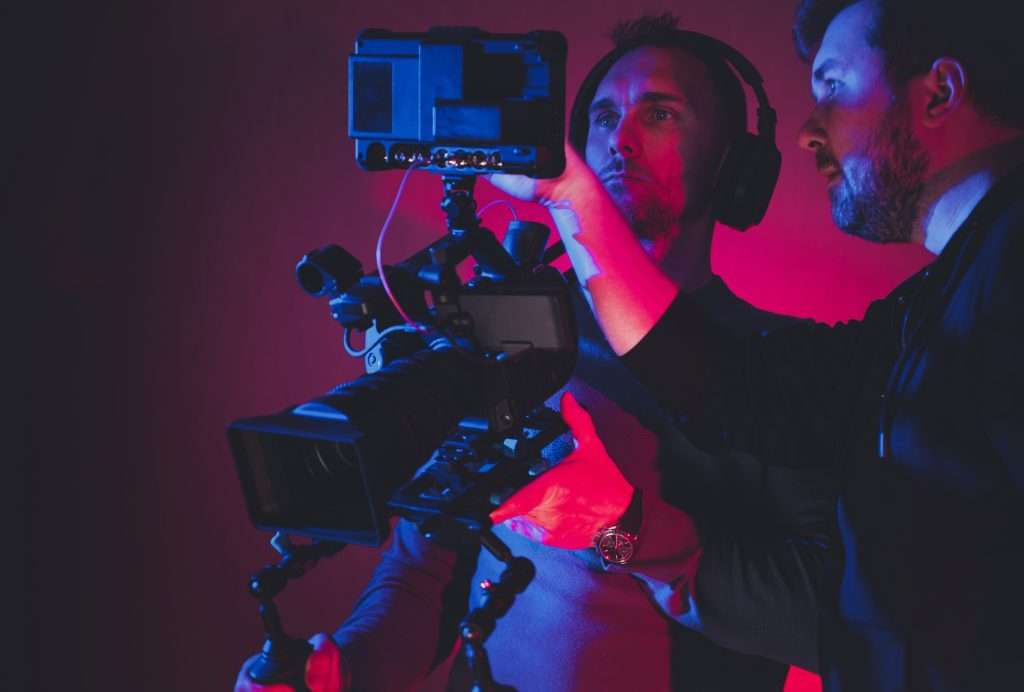Musing over whether cinematography and filmmaking are one and the same? You’re not alone. It’s a common conundrum amongst cinema enthusiasts until it becomes clear that while they may intertwine, these terms highlight different facets of film production.
In this article, we are about to peel back the layers of their distinctive roles and invaluable contributions in sculpting cinematic masterpieces. Are you prepared to embark on a refreshing exploration into the world of films?.
Key Takeaways
- Cinematography and filmmaking are related but distinct fields within the film industry.
- Cinematography focuses on creating visually stunning scenes through techniques like lighting, camera angles, and composition.
- Filmmaking involves the entire process of storytelling through film, including writing, directing, editing, and producing.
- While both require artistic and technical skills, cinematography is just one aspect of the broader field of filmmaking.
Understanding Cinematography: A Closer Look

Cinematography is all about creating visual images. We see these in movies or TV shows. It uses different techniques like lighting, camera angles and movement. Cinematographers carry out this task.
They work with directors and other crew members to show the director’s ideas through pictures.
Not just artistic, but technical skills are needed for cinematography as well. This area focuses on how a film looks. Every shot should be composed thoughtfully to tell the story of the film best way possible.
Even though it might seem like an art, it also relies heavily on science especially when it comes to working with lights and cameras.
What Is Filmmaking??

Filmmaking is like telling a story, but with pictures and sound. It begins with an idea. This can be anything from a real-life event to something someone thought up in their brain.
The idea becomes a script or a plan for the film. Then, everything gets shot by the camera crews into scenes or parts of the story. After that comes editing where the shots are put in order to make sense and sound effects or music get added too.
We call this whole process filmmaking because it involves many creative jobs like writing, directing, producing as well as technical ones such as camera work and lighting. All these people must work together to make sure their piece of work adds up to a great film experience for viewers on screen.
So while filmmaking covers everything needed to tell our stories through movies; each job within has its own important part in this purpose including cinematography which we will talk about next!
Differences Between Cinematography and Filmmaking
Cinematography and filmmaking differ in terms of skills, education, projects, responsibilities, and crew size. Understanding these differences can shed light on the distinct roles within the film industry.
Read more to explore these disparities between the art of capturing visuals and the broader scope of creating films.
Skills and Education
In the world of film, both filmmakers and cinematographers possess a unique set of skills and education. Further, due to the nature of their roles, filmmakers might require a broader range of technical and creative skills whereas cinematographers might need more specialised knowledge in their field.
| Filmmaking | Cinematography |
|---|---|
| Storytelling skills | Understanding of camera technology |
| General Knowledge of all aspects of filmmaking | Ability to create visual aesthetics |
| Understanding of the editing process | Expertise in lighting techniques |
| Marketing and business acumen | Comprehension of colour grading |
| Higher education, such as a degree in Film Studies, often preferred | Often a degree in Cinematography or a related field |
In a nutshell, despite being interrelated, the roles of a filmmaker and a cinematographer are not the same, and they both require different sets of skills and levels of education. Whether they’re bringing a script to life or creating captivating visuals, they all play a crucial part in the film industry.
Projects
Cinematographers and filmmakers work on different types of projects that vary in scope and responsibility.
| Cinematography | Filmmaking |
|---|---|
| Cinematographers primarily focus on the visual aspects of a project. This might involve creating a specific aesthetic for a film, shooting a dramatic scene with complex lighting and camera angles, or operating advanced camera equipment. | Filmmakers are involved in a project from its conception to its completion. They might write the script, cast the actors, oversee the shooting process, edit the film in post-production, and even help with marketing and distribution. The filmmaker’s goal is to ensure that the entire film comes together as a unified piece of art. |
While both positions work closely together, their roles are distinct, and their contributions are essential in creating the final product.
Responsibilities
In filmmaking and cinematography, the roles and responsibilities vary significantly.
| Cinematography | Filmmaking | |
|---|---|---|
| 1 | Cinematographers capture and create the visual images seen in a film or television show. | Filmmakers comprehend the overall process of storytelling through film, including elements such as writing, directing, editing, and producing. |
| 2 | They handle technical aspects such as composition, lighting, camera angles, and movement. | Filmmakers are responsible for conceptualizing, scripting, filming and in post-production stages. |
| 3 | These professionals work closely with directors and other professionals to bring the director’s vision to life through visual storytelling. | Filmmaking is a collaborative effort involving multiple individuals with different roles and responsibilities. |
| 4 | Cinematographers play a key role in shaping the visual aesthetics of a film. | Filmmakers oversee the entire film process, right from its conception to its release and promotion. |
Although these roles intersect at various points in the creation of a film, each one holds a unique position in the production process. It’s the harmonious collaboration of these roles that lead to the creation of the complete cinematic experience.
Crew Size
The crew size in filmmaking and cinematography varies a lot. In filmmaking, the number of people can be large. This big team writes, directs, acts, edits and gives final touches to the film. They cover every step from start to end.
On the other hand, a cinematographer’s team is smaller but very important as well. Their main job is capturing footage with art and skill. Lighting experts and camera crews work under them closely. Together they create a powerful visual story for all to see.
Cinematography vs. Videography
Cinematography and videography may seem the same. This is not true. Cinematographers work on films or TV shows. They use different skills to tell a story with visuals. Lights, camera angles, and scene setups are some tools they use.
Videographers, however, usually capture live events like weddings or parties. They focus more on making sure all parts of the event get caught on tape. The aim is not always to tell a story but to record an event as it happens.
Both jobs have their own worth and both need skill at using a camera. Yet they offer very different roles in film and video production.
Other Differences
In addition to the differences already mentioned, there are a few other distinctions between cinematography and filmmaking:
- Perspectives: Cinematography focuses on capturing images from a visual perspective, emphasizing the use of light, camera angles, and composition to tell a story. Filmmaking, on the other hand, encompasses various perspectives including writing, directing, and editing to create a cohesive narrative.
- Event Capture: Cinematography involves capturing events as they happen and transforming them into visually stunning footage. Filmmaking takes those captured events and crafts them into a complete film through storytelling techniques like editing, sound design, and narrative structure.
- Film Production: Cinematography is just one aspect of film production. Filmmaking includes all stages of creating a movie from start to finish – writing the script, securing funding for production, selecting actors/actresses for roles, shooting scenes with cinematographers’ help, editing footage into a cohesive story.
- Director’s Role: While cinematographers work closely with directors to achieve their artistic vision through visuals, directors in filmmaking have broader responsibilities that go beyond cinematography. They oversee every aspect of the film production process and guide the overall creative direction.
Conclusion
In conclusion, cinematography and filmmaking are closely connected but distinct. Cinematography is the art and science of capturing visual images in a film, while filmmaking involves the entire process of storytelling through film.
While both require artistic and technical skills, cinematography focuses specifically on creating visually stunning scenes. So, although they overlap in certain areas, cinematography is just one aspect of the broader field of filmmaking.
Do cinematographers only focus on shooting films, or do they work in other areas of filmmaking as well?
Cinematographers excel in three areas of cinematography: shooting films, controlling the visual elements, and collaborating with directors. They skillfully capture breathtaking shots, exploit lighting techniques, choose suitable camera angles, and create the desired mood. Their expertise extends beyond shooting, as they actively contribute to the overall storytelling process, guaranteeing a seamless cinematic experience.
What Are the Differences Between Cinematography and Filmmaking?
Cinematography versus videography differences lie in their distinct artistic approaches. Cinematography primarily focuses on the technical aspects of capturing and portraying visuals, emphasizing aesthetics and storytelling. Filmmaking, on the other hand, encompasses the entire process of creating a film, including directing, screenwriting, and post-production. Understanding these nuances helps in recognizing the divergent yet complementary roles these disciplines play in the world of film and video production.
FAQs
1. What is cinematography?
Cinematography is the art and technique of capturing moving images on film or digital media, including the use of lighting, camera angles, and composition.
2. What does filmmaking refer to?
Filmmaking refers to the entire process of creating a film, which includes planning, directing, producing, editing, and distributing movies.
3. Are cinematography and filmmaking the same thing?
No, cinematography is a part of filmmaking that specifically focuses on capturing visually appealing scenes through camera work. Filmmaking encompasses all aspects of creating a film.
4. Who is responsible for cinematography in a film?
The cinematographer or director of photography (DP) is responsible for overseeing the camera crew and making creative decisions related to lighting, framing, and camera movement.
5. Can you have good cinematography without good filmmaking?
No, good cinematography alone does not guarantee a successful film. While visually stunning shots can enhance the overall quality of a movie, effective storytelling through writing and direction are also crucial components in filmmaking.






